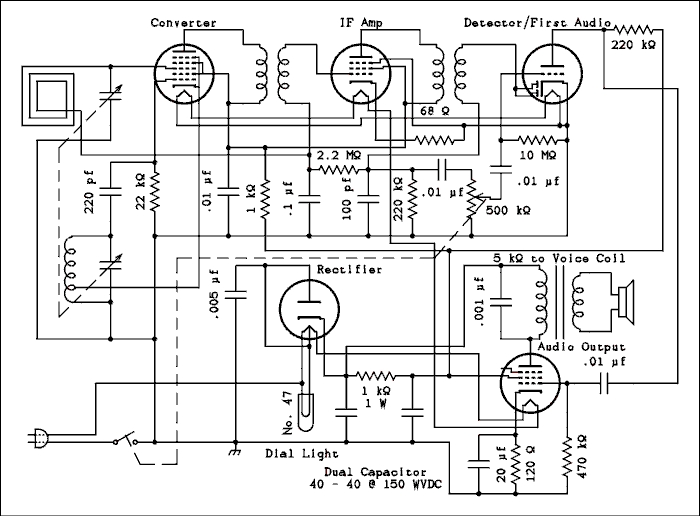
For a verbal description of newly added parts click here.
For a verbal description of the complete diagram click here.
Here we are near the end of this series. The audio amplifier takes the audio signal from the detector and increases the power to a high enough level to drive a speaker. There is a considerable amount of reserve built into it so you rarely have to turn the volume control up to full. Here is the entire circuit.

For a verbal description of newly added parts click here.
For a verbal description of the complete diagram click here.
The audio from the detector goes through the volume control, through a capacitor to the grid of the first audio amplifier. The cathode of this tube is grounded because the triode and diodes use one cathode in common and the diode cathode has to be grounded. The triode is biased using contact bias or what some people call grid leak bias. The capacitor keeps the volume control from shorting out the bias voltage. The grid of the triode is at about -0.7 volts. This negative voltage is developed because there are so many electrons that some of them run into the grid wires. This places a negative charge on the grid and after it builds up to a certain point the grid begins to repel additional electrons. The electrons leak off gradually through the 10 meg ohm resistor. The equilibrium condition sets the voltage at about -0.7 volts. The Voltage gain of this stage is about 50. For a more detailed discussion of how amplifier stages of this type work see Resistance Coupled Amplifier, a basic building block.The audio signal goes from the first audio amplifier to the audio output stage. This is a power amplifier. A resistance coupled amplifier (voltage amplifier) increases the voltage of an audio signal but the power remains quite low, a few milliwatts. The output of a power amplifier is measured in watts. In the case of an All American 5 the output power isn't much more than one watt. This is called a single ended amplifier to distinguish it from a push-pull amplifier.
The transformer between the plate of the output tube and the speaker is to match the impedance. It is a step down transformer. When I was just learning about radio circuits I used to wonder why they went to all that trouble to amplify the signal up to a high voltage and then step it down. What I didn't understand was current. When a transformer steps the voltage down it steps the current up. A speaker needs a lot of current at a little voltage. The plate of a tube delivers a lot of voltage at a little bit of current. The output transformer matches the plate of the tube to the speaker.
In some versions of the AA5 there is a large (20 microfarads) capacitor across the cathode resistor of the output tube. Some radios leave it off to save a few cents. Leaving the capacitor off reduces the gain of the audio amplifier by about 6 dB, a factor of 2 in voltage.
Well, that's about it. If you still have questions don't hesitate to email me.
Next; Cautions, Precautions and Troubleshooting.
Or use your "Back" button to return to where you were.
Thank you for visiting my page at Angelfire.
Please come back and visit again!This site begun March 14, 2001
This page last updated August 21, 2002